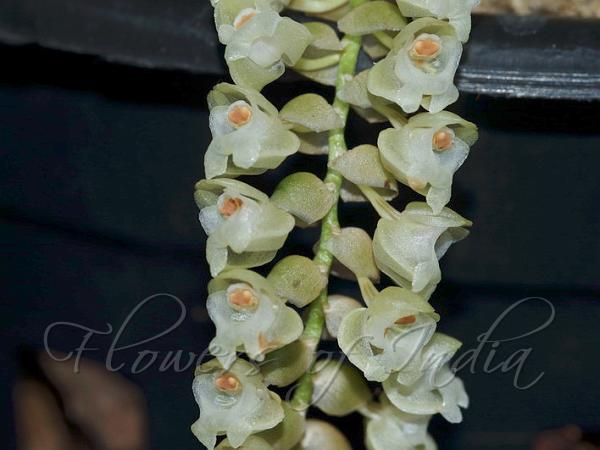|
| Necklace Orchid |
|

|

| File size | 102392 |
| Original date | 9/16/22 10:54 AM |
| Resolution | 800 x 533 |
| Flash | Flash fired |
| Focal length | 100.0mm |
| Exposure time | 1/250s |
| Aperture | 8.0 |
| Focus Distance | |
| Metering Mode | Multi-segment |
| Camera make | Canon |
| Camera model | Canon EOS 7D Mark II |
| Sensor type |
|
|
|
|
Photo: |
Botanical name: Coelogyne imbricata Family: Orchidaceae (Orchid family)
Synonyms: Pholidota imbricata, Pholidota bracteata, Pholidota crotalina
Synonyms: Pholidota imbricata, Pholidota bracteata, Pholidota crotalina
Necklace Orchid is an orchid growing on trees,
with crowded pseudobulbs and clustered roots. Pseudobulbs are 4-6 cm
long, oblong-conical, tetragonous, with large deciduous sheathing
scales. Leaves are 1-2 from the tip of pseudobulb, 14-25 x 3.2-5.5 cm,
elliptic-inverted-lanceshaped, base narrowed, tip pointed or blunt,
leathery, strongly 3-nerved. Racemes drooping, in leaf-axils, 20-27 cm
long. Flowers are pinkish-white, hidden by overlapping leaf-like
persistent bracts; bracts up to 6 x 5 mm, ovate-blunt. Sepals are
subequal, to 7 x 5 mm, ovate, tip blunt or pointed, 3-nerved. Petals
are up to 6 x 2.5 mm, linear-oblong. Lip to 8 x 8 mm, deeply saccate,
sac longitudinally 3-ridged within, 3-lobed, mid-lobe bifid. Column
round-ovate, winged. Anthers 2-loculed, pollinia 4. Capsule is
ellipsoid, drooping. Necklace Orchid is found in the Himalayas, at
altitudes of 600-2900 m, from Kumaun to Bhutan, Western Ghats, Ceylon,
Burma, W. China, Malaysia, Australia. Flowering: July-September.
Medicinal uses: Pseudobulbs are eaten in rheumatic diseases, and
are also believed to ve useful in flatulence and stomach disorders.
The extract mixed with mustard oil is applied to swelling joints and is
also considered useful in lumbago.
Pseudobulbs are eaten in rheumatic diseases, and
are also believed to ve useful in flatulence and stomach disorders.
The extract mixed with mustard oil is applied to swelling joints and is
also considered useful in lumbago.
Medicinal uses:
 Pseudobulbs are eaten in rheumatic diseases, and
are also believed to ve useful in flatulence and stomach disorders.
The extract mixed with mustard oil is applied to swelling joints and is
also considered useful in lumbago.
Pseudobulbs are eaten in rheumatic diseases, and
are also believed to ve useful in flatulence and stomach disorders.
The extract mixed with mustard oil is applied to swelling joints and is
also considered useful in lumbago.
| Identification credit: Siddarth Machado, Pankaj Kumar | Photographed at Shillong, Meghalaya, Churachandpur distt, Manipur & Mangan, North Sikkim. |
• Is this flower misidentified? If yes,